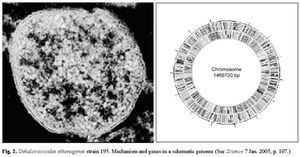Dehalococcoides ethenogenes
A Microbial Biorealm page on the genus Dehalococcoides ethenogenes
Classification
Higher order taxa
Domain: Bacteria; Phylum: Chloroflexi; Class: Dehalococcoidetes; Order: Dehalococcoides
Species
Dehalococcoides sp.
Description and significance
Describe the appearance, habitat, etc. of the organism, and why it is important enough to have its genome sequenced. Describe how and where it was isolated. Include a picture or two (with sources) if you can find them.
This species reduces chlorinated hydrocarbons in contaminated environments. It is the only known bacterium which completely dechlorinates tetrachloroethene to ethylene. This organism was isolated from environments polluted with organic chlorinated chemicals such as tetrachloroethene (PCE) and trichloroethane (TCE), common contaminants in the anaerobic subsurface.
Genome structure
Describe the size and content of the genome. How many chromosomes? Circular or linear? Other interesting features? What is known about its sequence? Does it have any plasmids? Are they important to the organism's lifestyle?
Dehalococcoides ethenogenes (strain 195)
Genome Size(Mb): 1.5; Chromosome: 1
Cell structure and metabolism
Describe any interesting features and/or cell structures; how it gains energy; what important molecules it produces.
Cellular features: Gram Positive; Shape: Irregular coccus; Environment: Non-Methanogenic, Non-Acetogenic, Mesophilic, Anaerobic, Multiple Habitat
There are at least 15 organisms from different metabolic groups such as acetogens and methanogens that are able to metabolize PCE. Some of these organisms remove their halogen atoms to conserve energy. Also, they utilize PCE as the only source of energy while others dehalogenate tetrachloroethene. This culture is able to grow with hydrogen as the electron donor, indicating that hydrogen and PCE serves as an electron donor or acceptor for energy conservation and growth.
Ecology
Describe any interactions with other organisms (included eukaryotes), contributions to the environment, effect on environment, etc.
Dehalococcoides ethenogenes most common use is for cleaning toxic messes by PCE. PCE is a suspected human carcinogen. Short-term exposure causes dizziness, headaches, and problems with balance, while long-term exposure has been linked to cancers of the esophagus, bladder, and blood. Therefore, D. ethenogenes breakdown the PCE to minimize its symptoms.
Pathology
How does this organism cause disease? Human, animal, plant hosts? Virulence factors, as well as patient symptoms.
This organism can use hydrogen to render PCE, a toxic chemical used by the dry cleaning industry, completely harmless as ethene and chlorine.
Application to Biotechnology
Does this organism produce any useful compounds or enzymes? What are they and how are they used?
Dehalococcoides ethenogenes is only known bacteria that can breakdown PCE, a dangerous and toxic carcinogen in chemical working environments. This organism converts PCE and Hydrogen to Chlorine and Ethene, which render the toxin completely harmless.
Current Research
Enter summaries of the most recent research here--at least three required
1) The solvents tetrachloroethene (PCE) and trichloroethene(TCE) are among the most pollutants at contaminated groundwater sites. Under aerobic conditions, PCE is considered can't be reduced, while TCE can be broken down to mainly nontoxic products by certain nonspecific oxygenases. Under anaerobic conditions, PCE and TCE have been reductively dechlorinated to less-chlorinated ethenes.
2) The anaerobic bacterium Dehalococcoides ethenogenes is the only known organism that can completely dechlorinate tetrachloroethene or trichloroethene (TCE) to ethene. One of two enzymes responsible for this pathway, TCE reductive dehalogenase (TCE-RDase) catalyzes the dechlorination of TCE to ethene. This info about the substrates of TCE-RDase may be used to predict the reactivity and the products of other environmental or industrial significance. Some of the compounds that were examined are pollutants.
3) Today, in the United States, the bacteria have been used to clean up chlorinated solvents in ten states at 17 sites including Kelly Air Force Base in Texas and Caldwell Trucking Superfund Site in New Jersey. For SiREM, business has been good of late; 13 of the sites were done in the past 18 months.
References
[Real reference] Seshadri R et al., "Genome sequence of the PCE-dechlorinating bacterium Dehalococcoides ethenogenes.", Science, 2005 Jan 7;307(5706):105-8
Edited by Tim Hou of Rachel Larsen and Kit Pogliano


